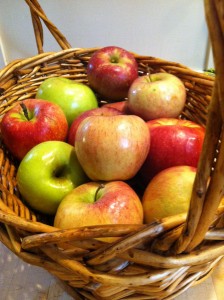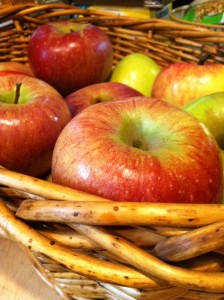 You know it’s fall when you have the urge to make applesauce—and today the itch struck. So I walked down to Sobsey’s, my local go-to purveyor of outrageously delicious produce. In front of the shop, under the awning, were a dozen cartons of low-spray apples from upstate New York—Braeburn, Cameo, Granny Smith, and more. Which ones make the best sauce, I asked? Mac, the resident culinary expert, pointed me to an amazing mix of Mutsu, Winesap, Jonagold, and Fuji—some tart, some sweet—that he said would create a complex tasting blend.
You know it’s fall when you have the urge to make applesauce—and today the itch struck. So I walked down to Sobsey’s, my local go-to purveyor of outrageously delicious produce. In front of the shop, under the awning, were a dozen cartons of low-spray apples from upstate New York—Braeburn, Cameo, Granny Smith, and more. Which ones make the best sauce, I asked? Mac, the resident culinary expert, pointed me to an amazing mix of Mutsu, Winesap, Jonagold, and Fuji—some tart, some sweet—that he said would create a complex tasting blend.
I wasn’t disappointed. “What are you cooking? It smells delicious,” my husband called from upstairs as the aromas began wafting through the apartment. The tantalizing scents suggested much more than just simmering apples—buttery and spicy, warm and comforting, without my adding anything to the pot other than apples and water. Normally at the end I would stir in some sugar and lemon to enhance both the sweet and tart characteristics of the fruit (as in this applesauce recipe). Neither one was necessary. These apples were that flavorful. A touch of cinnamon, and I was done.
 Neither one of us could believe how delicious it tasted. We kept drifting back over to the pot on the stove to scoop another spoonful or two into our bowls. So here are my takeaway lessons.
Neither one of us could believe how delicious it tasted. We kept drifting back over to the pot on the stove to scoop another spoonful or two into our bowls. So here are my takeaway lessons.
1. It’s the apples, stupid. Start with great tasting apples, and you can’t go wrong.
2. If you want to give your applesauce extra texture and boost the nutrition too, leave the skins on. Bonus: You can cut your prep time in half because you won’t have to peel all those apples. It’s a win-win-win. (If you don’t want quite so many chewy peels in the final product, you can also grate the outside of the apple before cooking and add the grated bits of peel to the pot. They will disappear into the mix. I did a combination of the two.)
And now it’s time for another bowlful.
